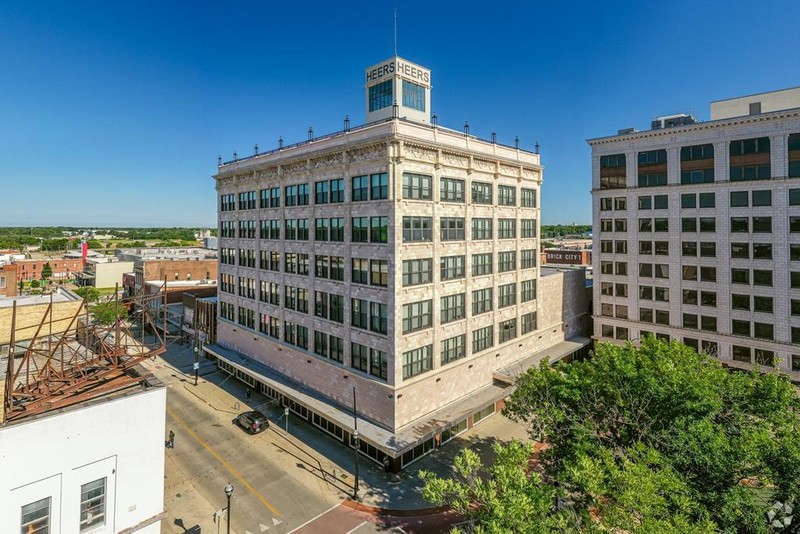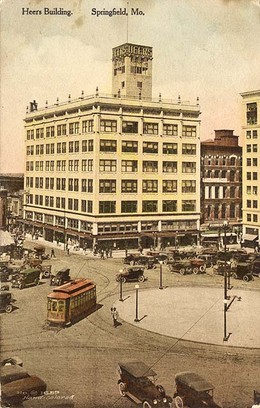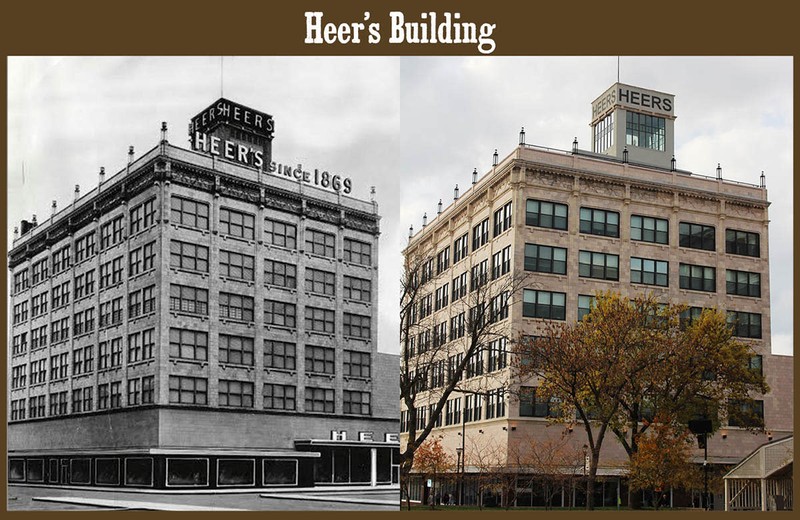Heer's Department Store (1915-1995)
Introduction
Text-to-speech Audio
Heer's Department Store opened in 1915 at a time when Springfield was becoming the commercial hub of southwest Missouri. The city, which is located on the Springfield Plateau of the Ozarks, enjoyed steady growth from the Civil War through the 1920s. At the start of the war, fewer than 1,500 people resided in Springfield but by the time this store opened, the population neared 40,000. In 1910, the Springfield Jobbers' and Manufacturers' Association organized to promote and build the city's commercial and industrial interests. Amidst that commercial growth, Heer's went on to serve as one of the region's most successful department stores in the region, operating in Springfield's Public Square for eighty years. The historic building not only served the community as a store, but had an observation deck, garden, tea room, and a theatre with free admission.
Images
Heer's Building

1917 Postcard of Heer's Building

Then & Now photos of Heer's Building

Backstory and Context
Text-to-speech Audio
German immigrant Charles H. Heer (1820-1898) founded Heer's Department Store in 1869 and incorporated as Charles H. Heer Dry Goods Company in 1882. Heer had been involved in business pursuits in the Midwest for several years before he visited Springfield in 1868. So impressed with the prospects of the growing Ozarks city, Heer purchased land there within twenty-four hours of his arrival and soon after arranged to have a store built upon the property. Although Heer established the store in Springfield, Missouri, he and his family remained in Waterloo, Illinois, until 1871.
Charles H. Jr, worked as a manager for the store for a while, but his youngest son, Francis X. Heer, took over as manager in 1886 and then became president in 1898 when his dad, Charles Sr., died. (Charles Jr. worked as secretary of the company until he died in 1911). Francis ultimately ran the store for more than half of a century.
The original store quickly became one of the most successful stores in the region by the end of the nineteenth century. When Francis worked in sales, he deplored price haggling. So, despite the objections of some employees, he instituted the modern flat-rate pricing system, and it worked. By the 1890s, Francis ended the wholesale end of the business and focused solely on retail sales. So, it made sense to move the store to a more attractive location, which Francis did in 1903 when he relocated the business to the Springfield public square.
A devastating fire burned down Heer's store (among many other buildings in the area) in 1913. But, the company's insurance prevented the store from suffering any financial losses. Turning tragedy into opportunity, Francis established temporary stores while planning to build a new, bigger, and more modern store.
The company ran ads in the local papers for months before the 1915 opening, providing updates on the construction progress while encouraging people to shop at its temporary store near the public square. The ads grew larger as opening day approached and included promotions of its grand opening party, imploring "every man and every woman within a hundred miles of Springfield" to attend. When the store opened on September 24, 1914, more than 21,000 people attended (a whopping forty-four people entered the store's doors every second), quite a feat for a city with a population of 35,201.
The building included an observation area at the top of the tower (complete with field glasses for customers' use), a rooftop garden outfitted with umbrellas, linen-covered tables, and plants, a forth-floor tea room, and a fully-equipped 250-seat theater that customers could use for no charge. Other extra services consisted of a beauty shop, a spot to pay utility bills, and plenty of places to sit comfortably.
The structural design included a steel and concrete structure, metal-framed windows, and especially ornate terra cotta work. Furthermore, to guard against another fire, the new store had metal fire doors and a fully-operational sprinkler system fed by a number of gravity-driven water tanks.
Francis retired in 1940 and sold the store to Allied Stores of New York. But, the store continued to prosper. Though a chain, Allied allowed the store to effectively operated as an independent store under the Heer's name. In fact, that store enjoyed a 500% increase in business in the decade after Allied purchased the store. In 1950, Allied financed a massive remodeling project on the historic building. And, like the 1915 opening, ran full-page ads updating the public on the construction and promoting the changes that customers could expect, with much of the language targeted towards women. When the renovations were completed in 1951, the two notable upgrades included the installation of air conditioning (the store had more air-conditioned space than any store within a 150-mile radius of Springfield) and installing the first escalator in the entire "Ozark Empire."
Similar to other department stores in more rural communities of Missouri and other Border South states, it wasn't until In 1960 that Heer's opened their building open to persons of all races. At that time, some of the area's schools and colleges had ended formal segregation.
Allied completed more renovations in 1969 to give Heer's a look similar to large department stores found in the nation's biggest cities. During the 1970s and 1980s, Heer's stores could be found in malls, a sign of changing times within the retail industry and an attempt by the former dry goods store to "keep up with the times." But, the 1990s proved to be the end for the store: the company filed for bankruptcy and ceased operations in 1995.
When it closed, The Heer's Department Store ended its run as the largest department store in southwest Missouri and the most prominent retail operation in Springfield's Public Square. The store was vacant and in disrepair for nearly two decades, with new owners routinely buying and selling the property. Finally, an investment group purchased the blighted property in 2013 and transformed it into a luxury apartment building, which opened in 2015.
Sources
"Celebrating 100 years of memories with a look to the future." Ozarks Alive. ozarksalive.com. September 24, 2015. https://www.ozarksalive.com/stories/celebrating-100-years-of-memories-with-a-look-to-the-future.
Fairbanks, Jonathan and Clyde Edwin Tuck. Past and Present of Greene County, Missouri. Volume I. Indianapolis: A.W. Bowen & Company, 1915.
Kull, Katie. "Heer's building sold to North Dakota-based group, to be managed by TLC Properties." Springfield News-Leader (Springfield, MO), March 4, 2021. https://www.news-leader.com/story/news/local/ozarks/2021/03/01/springfield-heers-building-sold-north-dakota-based-group-managed-tlc-properties/6878184002/.
Sheals, Debbie. "Registration Form: Heer's Department Store." National Register of Historic Places. mostateparks.com. 2002. https://mostateparks.com/sites/mostateparks/files/Heer%27s%20Dept.%20Store.pdf.
Springfield-Greene County Library District. "Historical Postcards of Springfield, Missouri: Heer's Building." thelibrary.org. Accessed September 27, 2022. https://thelibrary.org/lochist/postcards/heers_building.cfm.
Realtor.com: https://www.realtor.com/realestateandhomes-detail/138-Park-Central-Sq_Springfield_MO_65806_M71419-92843
thelibrary.org Springfield-Greene County Library District, https://thelibrary.org/lochist/postcards/heers_building.cfm
https://www.springfieldmo.org/blog/post/historic-springfield-then-now/
